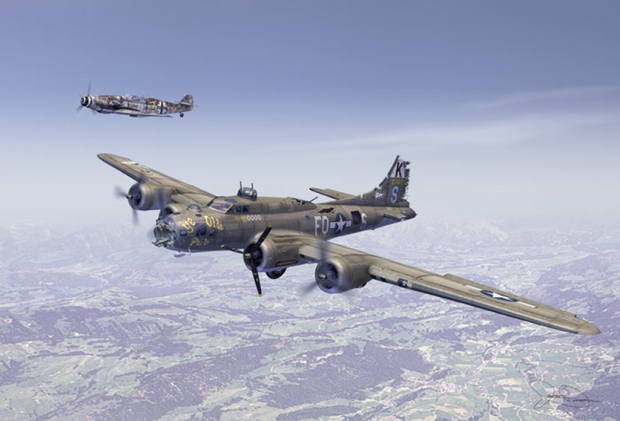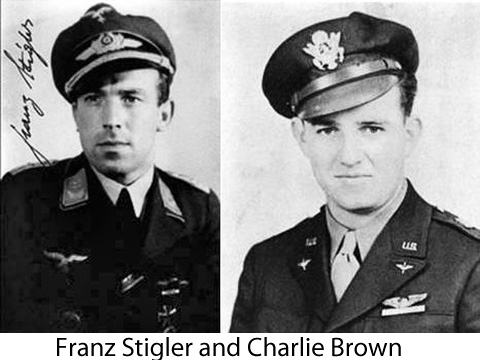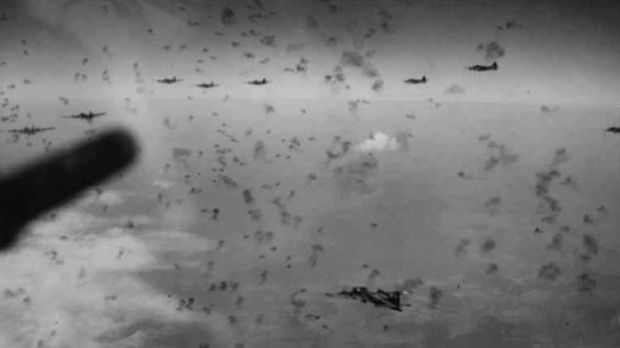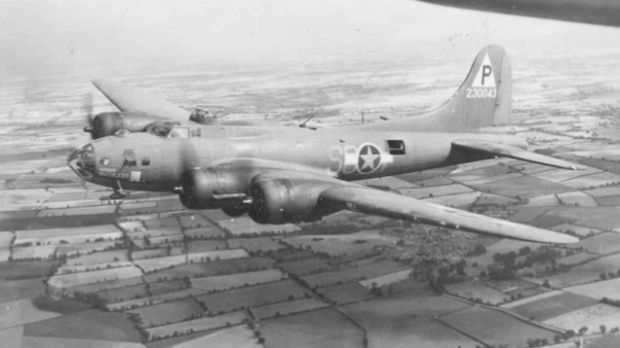
Considering the title and the picture above one could be forgiven to think that this incident was a dare fueled by alcoholic beverages, which were consumed in a pub.
But nothing could be further from the truth the “ye olde oub incident” or AKA “The Charlie Brown and Franz Stigler incident” was in fact one of those rare chivalrous acts by a German Luftwaffe pilot, you don’t often hear or read about.
The incident occurred on 20 December 1943, when, after a successful bomb run on Bremen, Charles “Charlie” Brown’s B-17 Flying Fortress (named “Ye Olde Pub”) was severely damaged by German fighters. Luftwaffe ace Franz Stigler had the opportunity to shoot down the crippled bomber, but for humane reasons, he decided to allow the crew to fly back to RAF Kimbolton in England.
2nd Lt. Charlie Brown (“a farm boy from Weston, West Virginia”, in his own words) was a B-17F pilot with United States Army Air Forces (USAAF)’s379th Bomber Group, stationed at RAF Kimbolton in England.Franz Stigler, a former airline pilot from Bavaria, was a veteran Luftwaffe fighter pilot attached to Jagdgeschwader 27; at the time, he had 22 victories to his name and would be eligible for the coveted Knight’s Cross with one more downed enemy bomber

Brown’s B-17F Flying Fortress, was typical of American heavy bombers of the time. Along with an 8,000-pound bomb capacity, the four-engine plane was armed with 11 machine guns and strategically placed armor plating. B-17s cruised at about 27,000 feet, but weren’t pressurized. At that altitude, the air is thin and cold — 60 degrees below zero. Pilots and crew relied upon an onboard oxygen system and really warm flight suits with heated shoes.
As Ye Old Pub approached Bremen, Germany, German anti-aircraft batteries opened up on the formation. Unfortunately for the pilots and crew of Ye Olde Pub, one of the anti-aircraft rounds exploded right in front of their plane, destroying the number two engine and damaging number four. Missing one engine and with another throttled back due to damage, Ye Olde Pub could no longer keep up with the formation.

The mission was the Ye Olde Pub crew’s first, and targeted the Focke-Wulf 190 aircraft production facility in Bremen. The men of the 527th Bombardment Squadron were informed in a pre-mission briefing that they might encounter hundreds of German fighters. Bremen was guarded by 250 flak guns, operated by the elite Officer Candidate School (OCS) of gunners. Brown’s crew was assigned to fly “Purple Heart Corner,” a spot on the edge of the formation that was considered especially dangerous.
Brown’s B-17 began its 10-minute bomb run at 27,300 ft (8,300 m) with an outside air temperature of −60 °C (−76 °F). Before the bomber released its bomb load, accurate flak shattered the Plexiglas nose, knocked out the number two engine and further damaged the number four engine, which was already in questionable condition and had to be throttled back to prevent overspeeding. The damage slowed the bomber, and Brown was unable to remain with his formation and fell back as a straggler – a position from which he came under sustained enemy attacks.
Brown’s straggling B-17 was now attacked by over a dozen enemy fighters (a mixture of Messerschmitt Bf 109s and Focke-Wulf Fw 190s) of JG-11 for over 10 minutes.
Further damage was sustained, including damage to the number three engine, which would produce only half power (meaning the aircraft had at best 40% of its total rated power available). The bomber’s internal oxygen, hydraulic and electrical systems were also damaged, and the bomber lost half of its rudder and its port (left side) elevator, as well as its nose cone. The gunners’ weapons then jammed, probably as a result of improper pre-mission oiling, leaving the bomber with only two dorsal turret guns and one of three forward-firing nose guns (from eleven available) for defense.Most of the crew were wounded: the tail gunner, Eckenrode, had been killed by a direct hit from a fighter shell, while Sgt Yelesanko was critically wounded in the leg by shrapnel,Sgt. Pechout had been hit in the eye by a shell fragment, and Brown was wounded in his right shoulder.The morphine syrettes onboard froze, complicating first-aid efforts by the crew, while the radio was destroyed and the bomber’s exterior was heavily damaged.
Brown’s damaged bomber was spotted by Germans on the ground, including Franz Stigler, who was refueling and rearming at an airfield. He soon took off in his Messerschmitt Bf 109 G-6 (which had a .50 Browning Machine Gun bullet embedded in the radiator which risked the engine overheating) and quickly caught up with Brown’s plane. Through the damaged bomber’s airframe Stigler was able to see the injured and incapacitated crew. To the American pilot’s surprise, Stigler did not open fire on the crippled bomber. Stigler recalled the words of one of his commanding officers from Jagdgeschwader 27, Gustav Rödel, during his time fighting in North Africa, “If I ever see or hear of you shooting at a man in a parachute, I will shoot you myself.” Stigler later commented, “To me, it was just like they were in a parachute. I saw them and I couldn’t shoot them down.”
Twice, Stigler tried to get Brown to land his plane at a German airfield and surrender, or divert to nearby neutral Sweden, where he and his crew would receive medical treatment and be interned the remainder of the war. Brown and the crew of the B-17 didn’t understand what Stigler was trying to mouth and gesture to them and so flew on. Stigler later told Brown he was trying to get them to fly to Sweden. Stigler then flew near Brown’s plane in a formation on the bomber’s port side wing, so German antiaircraft units would not target it; he then escorted the damaged B-17 over the coast until they reached open water. Brown, unsure of Stigler’s intentions at the time, ordered his dorsal turret gunner to point at Stigler but not open fire in order to warn him off. Understanding the message and certain that the bomber was out of German airspace, Stigler departed with a salute.
The bomber made it back to England, scarcely able to keep 250 feet between itself and the ground by the time it landed in a smoking pile of exhausted men and shredded aluminum. Years later, Brown would say that if Stigler had been able to talk to him, offering the land in Germany or fly to Sweden ultimatum, he probably would have gone to Sweden. But Ye Olde Pub did make it, and Brown got a much needed stiff drink handed to him when he got off the plane.

The incredulous debriefing officer, wowed by Brown’s story, went off to tell the brass what had happened. He recommended Brown’s crew for citation, but the glory was short-lived. Brass quickly decided that word getting out about a chivalrous German fighter pilot could endanger the lives of other crews if it caused them to let their guard down. All details of Ye Olde Pub’s first mission were classified Secret.
Stigler was never able to speak of his actions that day, as it would have meant certain court martial. He flew many more missions, though, becoming one of the world’s first fighter jet pilots. By the war’s end, he was one of only about 1,300 surviving Luftwaffe pilots. Some 28,000 had served..
After the war, Brown returned home to West Virginia and went to college, returning to the Air Force in 1949 and serving until 1965. Later, as a State Department Foreign Service Officer, he made numerous trips to Laos and Vietnam. But in 1972, he retired from government service and moved to Miami to become an inventor.
Stigler moved to Canada in 1953 and became a successful businessman.
In 1986, the then-retired Colonel Brown was asked to speak at a combat pilot reunion event called “Gathering of the Eagles”. Someone asked him if he had any memorable missions during World War II; Brown thought for a minute and recalled the story of Stigler’s escort and salute. Afterwards, Brown decided he should try to find the unknown German pilot.
After four years of searching vainly for U.S. and West German Air Force records that might shed some light on who the other pilot was, Brown hadn’t come up with much. He then wrote a letter to a combat pilot association newsletter. A few months later, Brown received a letter from Stigler, who was living in Canada. “I was the one”, it said. When they spoke on the phone, Stigler described his plane, the escort and salute confirming everything Brown needed to hear to know he was the German fighter pilot involved in the incident.
Between 1990 and 2008, Charlie Brown and Franz Stigler became close friends and remained so until their deaths within several months of each other in 2008.

Donation
I am passionate about my site and I know you all like reading my blogs. I have been doing this at no cost and will continue to do so. All I ask is for a voluntary donation of $2, however if you are not in a position to do so I can fully understand, maybe next time then. Thank you. To donate click on the credit/debit card icon of the card you will use. If you want to donate more then $2 just add a higher number in the box left from the PayPal link. Many thanks.
$2.00




